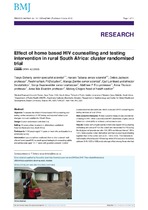| dc.contributor.author | Doherty, Tanya | |
| dc.contributor.author | Tabana, Hanani | |
| dc.contributor.author | Jackson, Debra | |
| dc.contributor.author | Naik, Reshma | |
| dc.contributor.author | Zembe, Wanga | |
| dc.contributor.author | Lombard, Carl | |
| dc.contributor.author | Swanevelder, Sonja | |
| dc.contributor.author | Fox, Matthew P. | |
| dc.contributor.author | Thorson, Anna | |
| dc.contributor.author | Ekström, Anna Mia | |
| dc.contributor.author | Chopra, Mickey | |
| dc.date.accessioned | 2017-06-29T08:43:55Z | |
| dc.date.available | 2017-06-29T08:43:55Z | |
| dc.date.issued | 2013 | |
| dc.identifier.citation | Doherty, T. et al. (2013). Effect of home based HIV counselling and testing intervention in rural South Africa: cluster randomised trial. BMJ, 346 (3481): 1-11 | en_US |
| dc.identifier.issn | 1756-1833 | |
| dc.identifier.uri | http://hdl.handle.net/10566/3017 | |
| dc.description.abstract | OBJECTIVE: To assess the effect of home based HIV counselling and testing on the prevalence of HIV testing and reported behavioural changes in a rural subdistrict of South Africa.
DESIGN: Cluster randomised controlled trial.
SETTING: 16 communities (clusters) in uMzimkhulu subdistrict, KwaZulu-Natal province, South Africa.
PARTICIPANTS: 4154 people aged 14 years or more who participated in a community survey.
INTERVENTION: Lay counsellors conducted door to door outreach and offered home based HIV counselling and testing to all consenting adults and adolescents aged 14-17 years with guardian consent. Control clusters received standard care, which consisted of HIV counselling and testing services at local clinics.
MAIN OUTCOME MEASURES: Primary outcome measure was prevalence of testing for HIV. Other outcomes were HIV awareness, stigma, sexual behaviour, vulnerability to violence, and access to care.
RESULTS: Overall, 69% of participants in the home based HIV counselling and testing arm versus 47% in the control arm were tested for HIV during the study period (prevalence ratio 1.54, 95% confidence interval 1.32 to 1.81). More couples in the intervention arm had counselling and testing together than in the control arm (2.24, 1.49 to 3.03). The intervention had broader effects beyond HIV testing, with a 55% reduction in multiple partners (0.45, 0.33 to 0.62) and a stronger effect among those who had an HIV test (0.37, 0.24 to 0.58) and a 45% reduction in casual sexual partners (0.55, 0.42 to 0.73).
Conclusions Home based HIV counselling and testing increased the prevalence of HIV testing in a rural setting with high levels of stigma. Benefits also included higher uptake of couple counselling and testing and reduced sexual risk behaviour. | en_US |
| dc.language.iso | en | en_US |
| dc.publisher | BMJ Publishing Group Ltd | en_US |
| dc.rights | Publisher retains copyright. Authors may archive the published version in their institutional repository. | |
| dc.source.uri | http://dx.doi.org/10.1136/bmj.f3481 | |
| dc.subject | HIV counselling | en_US |
| dc.subject | Testing | en_US |
| dc.subject | South Africa | en_US |
| dc.subject | Cluster randomised trial | en_US |
| dc.subject | HIV awareness | en_US |
| dc.subject | Stigma | en_US |
| dc.subject | Sexual behaviour | en_US |
| dc.subject | Vulnerability to violence | en_US |
| dc.title | Effect of home based HIV counselling and testing intervention in rural South Africa: cluster randomised trial | en_US |
| dc.type | Article | en_US |
| dc.description.accreditation | Department of HE and Training approved list | |

